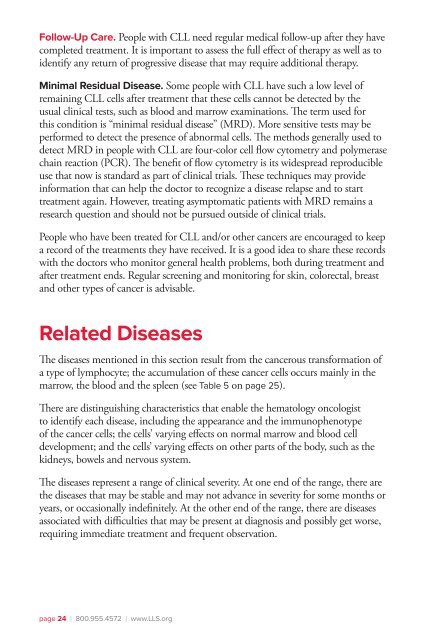Chronic Lymphocytic Leukemia - The Leukemia & Lymphoma Society
Chronic Lymphocytic Leukemia - The Leukemia & Lymphoma Society
Chronic Lymphocytic Leukemia - The Leukemia & Lymphoma Society
Create successful ePaper yourself
Turn your PDF publications into a flip-book with our unique Google optimized e-Paper software.
Follow-Up Care. People with CLL need regular medical follow-up after they have<br />
completed treatment. It is important to assess the full effect of therapy as well as to<br />
identify any return of progressive disease that may require additional therapy.<br />
Minimal Residual Disease. Some people with CLL have such a low level of<br />
remaining CLL cells after treatment that these cells cannot be detected by the<br />
usual clinical tests, such as blood and marrow examinations. <strong>The</strong> term used for<br />
this condition is “minimal residual disease” (MRD). More sensitive tests may be<br />
performed to detect the presence of abnormal cells. <strong>The</strong> methods generally used to<br />
detect MRD in people with CLL are four-color cell flow cytometry and polymerase<br />
chain reaction (PCR). <strong>The</strong> benefit of flow cytometry is its widespread reproducible<br />
use that now is standard as part of clinical trials. <strong>The</strong>se techniques may provide<br />
information that can help the doctor to recognize a disease relapse and to start<br />
treatment again. However, treating asymptomatic patients with MRD remains a<br />
research question and should not be pursued outside of clinical trials.<br />
People who have been treated for CLL and/or other cancers are encouraged to keep<br />
a record of the treatments they have received. It is a good idea to share these records<br />
with the doctors who monitor general health problems, both during treatment and<br />
after treatment ends. Regular screening and monitoring for skin, colorectal, breast<br />
and other types of cancer is advisable.<br />
Related Diseases<br />
<strong>The</strong> diseases mentioned in this section result from the cancerous transformation of<br />
a type of lymphocyte; the accumulation of these cancer cells occurs mainly in the<br />
marrow, the blood and the spleen (see Table 5 on page 25).<br />
<strong>The</strong>re are distinguishing characteristics that enable the hematology oncologist<br />
to identify each disease, including the appearance and the immunophenotype<br />
of the cancer cells; the cells’ varying effects on normal marrow and blood cell<br />
development; and the cells’ varying effects on other parts of the body, such as the<br />
kidneys, bowels and nervous system.<br />
<strong>The</strong> diseases represent a range of clinical severity. At one end of the range, there are<br />
the diseases that may be stable and may not advance in severity for some months or<br />
years, or occasionally indefinitely. At the other end of the range, there are diseases<br />
associated with difficulties that may be present at diagnosis and possibly get worse,<br />
requiring immediate treatment and frequent observation.<br />
page 24 I 800.955.4572 I www.LLS.org

















